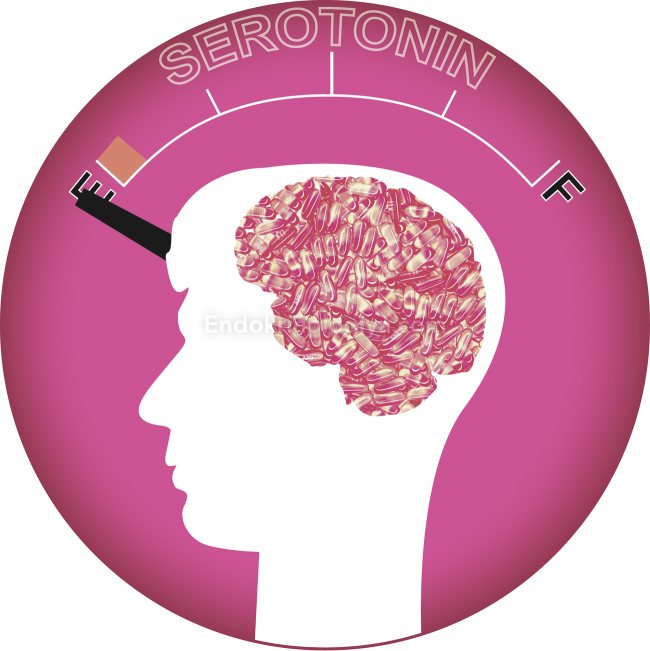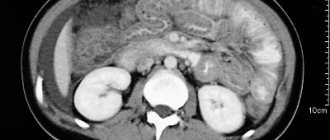SNRIs (selective serotonin norepinephrine reuptake inhibitors) are antidepressants that prevent the breakdown of two neurotransmitters: serotonin and norepinephrine.
SNRIs also help with neuropathy (associated with diabetes) and fibromyalgia. This occurs due to the joint inhibition of the reuptake of serotonin and norepinephrine. Increasing these two neurotransmitters reduces pain.
What is the happiness hormone responsible for?
First of all, for the work of neurons. In the CNS he is responsible for:
- good mood;
- memory;
- cognitive functions;
- regulates appetite;
- nutritional and sexual;
- social behavior of an individual.
One of its major functions is that melatonin, the sleep hormone, is produced from serotonin. Thus, serotonin is directly involved in circadian rhythms - sleep and wakefulness.
With melatonin deficiency, insomnia develops. Serotonin is also involved in thermoregulation and the functioning of the thyroid gland, increasing the production of TSH in the pituitary gland. Serotonin also increases the production of insulin, which, in turn, increases tryptophan. Therefore, after eating chocolate, your mood will improve: blood glucose rises, insulin rises, tryptophan rises, serotonin rises.
Serotonin increases the synthesis of prolactin and milk secretion, and is responsible for the proper course of pregnancy, childbirth and uterine contractions during them.
Participates in normal intestinal motility, stimulates respiratory rate, increases blood clotting, reduces pain sensitivity, and increases stress resistance. But excess serotonin exaggerates the positive, which is not very good.
Antidepressants
To bring a person out of a state of depression, it is necessary to resort to the prescription of various psychotropic drugs; Among them are new generation antidepressants – SSRIs. Meaning: selective serotonin reuptake inhibitors.
What can they give? How do they show themselves? They can improve mood, relieving a person of such negative aspects as anxiety and apathy, melancholy and emotional stress.
They make a person resistant to stress, restore biorhythms, stabilize sleep and improve appetite.
PsyAndNeuro.ru
According to the neuroscience-based nomenclature of psychotropic drugs, selective serotonin reuptake inhibitors (SSRIs) include 6 antidepressants: fluoxetine, paroxetine, sertraline, fluvoxamine, citalopram and escitalopram. The main mechanism of the antidepressant effect of this group is to block the reuptake of serotonin from the synaptic cleft, resulting in an increase in the concentration of this transmitter in the central nervous system. At the same time, SSRI antidepressants practically do not block the reuptake of norepinephrine and dopamine.
SSRIs are the most popular antidepressants. Despite this, there are many features of these drugs that sometimes remain unknown to the doctor. Based on the neuropsychopharmacology database, we have prepared the TOP 10 most interesting characteristics of SSRIs that will be useful to use in clinical practice:
1. Fluoxetine in combination with olanzapine is considered to be a fairly effective treatment option for treatment-resistant depression. In addition, fluoxetine is considered the best antidepressant for the treatment of atypical depression and can be off-label prescribed for selective mutism, mild agitation in dementia, and even Raynaud's disease.
2. Although paroxetine is contraindicated during pregnancy, most reputable reviewers consider paroxetine to be one of the most preferred antidepressants during breastfeeding.
3. Sertraline off-label can be prescribed for itching, which can be taken into account when choosing therapy for depressive and hypochondriacal disorders with similar complaints.
4. Escitalopram, in comparison with other SSRIs, has the weakest effect on the sexual sphere, which must be taken into account if there are similar complaints in patients previously identified during the use of other antidepressants or due to physiological abilities.
5. Unlike most SSRIs, which can cause diarrhea at the beginning of therapy, paroxetine, due to its pronounced m-cholinergic activity, can cause constipation.
6. Sertraline is considered an antidepressant with the most proven cardiac safety, which must be taken into account when prescribing therapy for the elderly.
7. In high doses, sertraline can also block the reuptake of dopamine, while other SSRI antidepressants in high doses begin to block the reuptake of norepinephrine. Because of these properties, sertraline is less likely to cause SSRI-associated apathy and anhedonia and increase prolactin.
8. Paroxetine is the drug of choice for the treatment of post-stroke depression due to good clinical efficacy and tolerability among patients who have previously suffered a stroke.
9. Specific side effects of SSRIs such as apathy/decreased emotional reactivity and decreased libido/delayed ejaculation can be used in the first case for increased emotional lability and impulsivity, in the second for premature ejaculation in depressed patients.
10 Probably the most well-known facts for practicing physicians are the more pronounced sedative effect of fluvoxamine and paroxetine, as well as the more activating effect of fluoxetine, which can be used for different subtypes of depression. However, fluvoxamine is FDA-registered only for the treatment of OCD and social anxiety, and cannot officially be used in the United States as an antidepressant.
Author: Kasyanov E.D.
Source: Neuropsychopharmacology Database
Mechanism of action of SSRIs
To understand the mechanism of their action, it is worth remembering a little the physiology of the central nervous system. At the sites where impulses are transmitted between neurons, there is a synaptic cleft, where serotonin, which carries information, is released.

What happens next: the mediator transmitted the signal, his role is over. Now he should be eliminated as unnecessary, on the principle that the Moor has done his job - the Moor can leave. The fact is that if the transmitter is not removed and remains on the postsynaptic membrane, it will interfere with the receipt of new information from new signals.
Removal of unnecessary neurotransmitter molecules occurs in several ways: diffusion, enzymatic breakdown and reuse by reuptake - serotonin reuptake. These reactions are very complex and there is no need to bother your head with them. You just need to know that SSRIs block the inhibition of these molecules and prolong the effect of serotonin, accumulating and sending it into the bloodstream.
The selectivity of inhibitors is manifested in the fact that they selectively act on only serotonin receptors. Thus, serotonin can no longer return to its cell; its signal goes to other cells that are in a state of inhibition and depression.
They are activated and depression gradually softens and decreases. Serotonin itself increases in the synaptic cleft and goes into the bloodstream, reaching other receptors too.
The half-life of the drugs takes about a day and is excreted by the kidneys. This group of antidepressants varies in terms of effectiveness.
Difference in Efficiency
Comparative clinical studies of representatives of the group of selective serotonin reuptake inhibitors show that drugs of this class reliably work. Each antidepressant reduces the severity of symptoms by at least half. However, there are some differences in effectiveness.
Escitalopram may provide more consistent results than other SSRIs in the treatment of major depressive disorder (1) and better efficacy than citalopram in the treatment of major depression.
Paroxetine is the only SSRI that can be prescribed for five types of anxiety disorders in addition to MDD.
Fluoxetine may exhibit antidepressant effects more slowly than other SSRIs.
Paroxetine, fluoxetine, and sertraline are similar in their effectiveness in treating MDD and depression with high anxiety levels (2).
Sertraline has advantages over paroxetine in the treatment of panic disorder (3).
List of SSRIs and their effects
The drugs are considered 3rd generation antidepressants. They have certain advantages and disadvantages. The pharmacological effect is manifested in the correction of a depressive background, reducing anxiety and melancholy, some phobias, improving appetite, and a slight analgesic effect.
The advantage of inhibitors is that they are easier to tolerate by patients, do not produce a cardiotoxic effect, do not aggravate glaucoma, and do not lead to severe sedation and hypotension, which is typical, for example, of TCAs (tricyclic antidepressants such as amitriptyline). SSRIs can be prescribed on an outpatient basis. They can also be prescribed if there are contraindications to the use of TCAs.
The most popular in use are: Fluoxetine, Prozac, Paroxetine, Citalopram, Indalpin, Sertraline, Fluvoxamine, Femoxetine, etc. The result of treatment does not appear immediately, only after 4-5 weeks.

Stimulation of serotonin receptors by stimulating them during the entire period of taking SSRIs necessarily produces side effects, like a double-edged sword: due to the fact that the receptors are represented very widely in various organs, with long-term use of SSRIs dyspeptic symptoms occur: abdominal pain, nausea and vomiting, stool disorders, even gastrointestinal bleeding; sexual disorders such as anorgasmia, delayed ejaculation. Insomnia (every 4-5 patients) and anxiety may occur. Disorders from the gastrointestinal tract are noted in 1-2 weeks of use, then they disappear. Violations on the part of the central nervous system are much more persistent.
List of SNRIs
Venlafaxine (Velaxin, Velafax, Venlaxor, Efevelon, Nyuvelong)
This drug was approved in 1993. At higher doses, Venlafaxine inhibits dopamine reuptake, thereby acting as an SSRI. An SSRI is a selective reuptake inhibitor of serotonin, norepinephrine and dopamine. Some evidence suggests that the norepinephrine transporter also increases dopamine in the prefrontal cortex. []
Duloxetine (Cymbalta, Intriv, Predanta)
This drug was released in 2004. In addition to its main effect, it also increases dopamine levels. It also has an analgesic effect, which is due to the blocking of sodium ion channels. This is the second most popular SNRI antidepressant (after Velaxin). []
Pristiq (Dezvenlafaxine)
This drug was approved in 2008. This is a synthetic form of the active metabolite in the drug Venlafaxine. It is believed to be 10 times more potent in inhibiting the reuptake of serotonin than norepinephrine. Venlafaxine differs from Pristiq in that the coefficient of inhibition of serotonin reuptake to norepinephrine is 3 times greater. []
Fetzima (Levomilnacipran)
This antidepressant was released in 2013. Contains the “levo” enantiomer of the drug Milnacipran and has a similar effect. Compared to other antidepressants, it provides a more balanced increase in both serotonin and norepinephrine. Its reuptake inhibition ratio is 1:2. []
Serotonin to norepinephrine reuptake ratio
Below are the relationships between serotonin and norepinephrine for various drugs.
It can be seen that Venlafaxine has the most flexible ratio. Newer drugs such as Cymbalta and Pristiq have narrowed the gap somewhat. But still more attention is paid to serotonin than norepinephrine. Fetzima, prefers norepinephrine, but has an almost balanced ratio: Venlafaxine - (30:1) Cymbalta - (10:1) Pristiq - (10:1) Fetzima - (1:2)
Indications
In addition to depression, SSRIs are prescribed for social phobias, anxiety neurosis, panic attacks, obsessions, anorexia, stress after injury, and chronic algia. In general practice, they are prescribed for uncontrolled appetite, obesity, PMS, borderline disorders, and alcoholism.
Opinions differ about the effectiveness of SSRIs: psychiatrists in Russia believe that selective inhibitors help better with moderate forms of depression - mild and moderate; in severe cases the effect is less. But in the West, they are doing their best to prove the effectiveness of these drugs for any form of depressive disorders.
SNRIs are not antidepressants
There are also several drugs in this group on the market that are not approved for the treatment of depression.
Sibutramine . This drug was released in 1998 and was used to suppress appetite and treat obesity. However, it has been associated with an increased risk of strokes and cardiovascular problems. Therefore, in 2010 it was withdrawn from sales. It had similar effects to SNRIs, but was very similar to amphetamines. The difference from amphetamines is that Sibutramine did not increase neurotransmitter levels, but simply inhibited their reuptake. []
Savella (Milnacipran) . This drug was approved in 2009 and was used to treat fibromyalgia. Milnacipran prevents the reuptake of serotonin and norepinephrine in a ratio of 1:3. []
What SSRIs are not compatible with
The simultaneous use of inhibitors and other drugs carries a great risk. SSRIs cannot be combined with MAOIs; this causes serotonin syndrome, one of the most serious complications in the patient. When combining TCAs and SSRIs, the dosage of TCAs is reduced, otherwise their amount may increase and a toxic effect may occur.
Lithium salts increase the serotonergic effects of SSRIs, and the unpleasant effects of lithium itself are more pronounced. SSRIs, when used simultaneously with antipsychotics, increase extrapyramidal disorders because they increase the level of antipsychotics in the blood serum.
The same applies to antipsychotics such as Rispolept (atypical). SSRIs cannot be combined with aspirin and NSAIDs, antiplatelet agents; the risk of gastrointestinal bleeding increases. In addition, NSAIDs significantly reduce the effect of SSRIs. The combination of the group with ethanol, sedatives, and barbiturates enhances the effect of the latter on the central nervous system.
SNRIs: list of drugs
There is an opinion in publications that SSRIs are not effective in the treatment of severe depression and chronic pain. The reason is that in these disorders the activity of not only serotonin is altered. Therefore, in the last decade of the 20th century - the first decade of the 21st century, representatives of a new generation of antidepressants became available for use in psychiatric practice:
These are semi-selective serotonin and norepinephrine reuptake inhibitors (SNRIs), “dual” action drugs. Venlafaxine was effective in patients with various diagnoses:
- depression;
- dysthymia – depression, sadness;
- generalized anxiety disorder;
- social phobias.
Good results with the use of venlafaxine have been achieved in elderly patients, in children with attention deficit hyperactivity disorder, and in children with autism. It is important to quickly achieve a significant therapeutic effect: after 2 weeks of treatment.
Milnacipran is effective both as a first-line drug for major depressive episodes and for long-term maintenance treatment. Pharmacokinetic properties and safety make the drug convenient for use in patients for whom it is difficult to choose an effective treatment regimen. Milnacipran is easy to use, safe, has little interaction with other drugs, and does not threaten the patient's life in case of overdose. Milnacipran treats major depression.
Serotonin syndrome
This dangerous, potentially fatal condition is perhaps the most serious side effect of SSRI use. It develops when they are combined with serotonergic antidepressants - for example, MAOIs.
The clinical picture has symptoms of 3 groups:
- From the central nervous system, autonomic nervous system and neuromuscular system.
- On the part of the central nervous system, any manifestations of excitement: dysphoria, agitation, hypomania and anxiety, dyssomnia and hallucinations, confusion and delirium.
- On the part of the ANS – symptoms of dyspepsia – rumbling in the abdomen, vomiting and nausea, loose stools, abdominal pain; fever, chills, hyperhidrosis, cephalgia, salivation and lacrimation, mydriasis, tachycardia, apnea, blood pressure surges.
Neuromuscular disorders: convulsions, increased reflexes - these 2 symptoms are the most common; disturbance of gait, coordination, paresthesia, muscle tension to the point of rigidity, spasm of the masticatory muscles, tremor of the whole body.

Against this background, CVS disorders occur, severe myopathy with the destruction of muscle tissue (rhabdomyolysis), the appearance of myoglobin in the urine - appears during the breakdown of protein, acute renal failure, liver failure, increased potassium content in the blood, a dangerous form of violation of the blood glucose level towards oxidation (acidosis), aspiration pneumonia, NK, strokes, drop in white blood cells and platelets, seizures. To prevent such a complication, you need to take some precautions: at least 2 weeks should pass between taking drugs of different groups.
The same principle must be observed when prescribing drugs from the same group. An interval of 5 weeks should be after discontinuation of Fluoxetine and the appointment of an irreversible MAOI, for the elderly - 8 weeks. For return transfer – 4 weeks.
At the first sign of complications, all medications taken are immediately discontinued. Then self-elimination of manifestations may occur within 24 hours. Symptomatic treatment of the condition is also carried out. In severe cases, serotonin antagonists are prescribed; infusion therapy; measures to reduce temperature, mechanical ventilation, lowering blood pressure, muscle relaxants.
Withdrawal syndrome
Withdrawal syndrome is characteristic not only of SSRIs, but also of all antidepressants. In this case, somatic and mental symptoms are noted. They occur with abrupt, immediate withdrawal of the drug and are difficult to tolerate by patients.
They go away in only 5-6 weeks. Moreover, the shorter the half-life of the drug taken, the more severe the withdrawal syndrome. This syndrome especially occurs when taking Paroxetine, followed by Fluvoxamine.
What symptoms might there be? Weakness and cephalgia, dizziness, nausea and vomiting, diarrhea, muscle pain, paresthesia, tremors, insomnia, unsteady gait, unreasonable anxiety and irritability, agitation, mood swings, panic attacks and arrhythmias.
Anxiety and depression produce similar withdrawal symptoms. In such cases, the drug is resumed and gradually withdrawn. To prevent this syndrome, medications should be gradually discontinued, over a period of at least a month.









